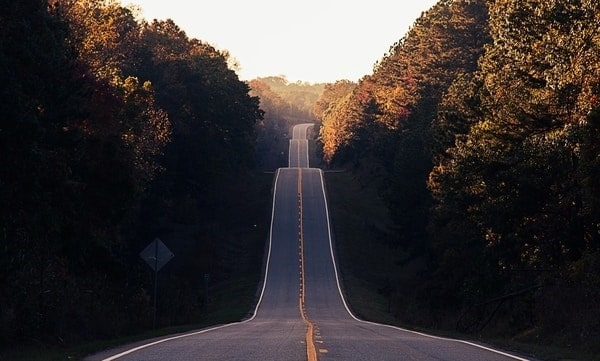
Anyone learning to ride a motorcycle or even riders who live in flatter regions, knows the pressure of stopping on a hill and trying to start, or trying to keep speed going up a steep hill. Hill management is a skill that every rider should have.
There’s a lot that can go wrong when on an incline, and proper riding techniques are critical to staying safe. As always when learning a new skill, be aware of your limitations, and try not to go beyond what you know, and practice regularly so that when the time comes you can be both knowledgeable and confident, and in the end, safe.
How do I ride uphill on a motorcycle? There are several steps to follow when riding a motorcycle uphill. You’ll need to give the motorcycle more gas than usual and keep the RPM’s above 2,000 which requires smooth dowshifting when necessary. If you stall or need to stop, make sure you apply both brakes to ensure you stay stationary.
Riding uphill should not be something that’s avoided, but should be a confidence held by every rider. For new riders, motorcycles can be overwhelming and the amount of things to keep track of while riding can be exhausting. Today we will look at the process of riding uphill and address some questions that relate to it like, ‘How much of uphill riding relies on being in the right gear?’, or ‘What are some tips to help a beginner become more comfortable starting on a hill?
How To Properly Ride Uphill On A Motorcycle
To address riding a motorcycle uphill, we will look at the two different situations that you will find yourself going uphill. First, you’ve come to a stop on a hill and need to start again, and second, you’re riding up a steep hill on a highway or road where you are trying to maintain your speed. I don’t know about you guys, but for me, starting on a hill is more difficult than just maintaining speed, so we will look at that first.
Let’s say you’ve stopped at a light that’s on a steep hill and the light just turned green. Normally what you do is release the clutch, twist the throttle, and boom off you go. But a hill can be little bit different. If you aren’t careful or quick enough, you might start rolling back or even stall your bike, but this is avoidable if you have the proper technique.
Let’s address that first concern, rolling back. To keep yourself from rolling back, you need to have both the front brake and the rear brake engaged, with your other foot planted firmly on the ground. As you accelerate, don’t just release the brakes, this will cause the motorcycle to begin rolling. When you start to release the clutch, make sure you keep your right foot on the back brake until you feel the bike holding, or start moving forward.
Next, how do you prevent yourself from stalling? Now that you aren’t rolling back, you need to focus your attention on not stalling the motorcycle. The best way to do that is that you want to give the bike more gas than usual. Because it’s on a hill, it will take the engine a little more work to move it, and this means that you give it a little more gas.
As you give it gas, feel the clutch to make sure that you are in the friction zone. Some of this might seem ridiculous if you’re a more experienced rider, but when going uphill, the location of the friction zone on the clutch might feel a little different, so it’s important to feel where it is before you release it all the way.
Now that you’re moving, how do you maintain a good speed when moving uphill? This mostly has to do with both following your rpm’s and downshifting in gears to make sure that the gear you’ve chosen matches the riding condition.
Why Your Gear Depends On RPM
The load on your engine has a lot to do with the rpm that is measured by your motorcycle’s dials. Using the rpm’s that your bike is reading is a great way to manage a steep hill climb. If you haven’t noticed by now, as you shift gears on your bike, the rpm’s will drop with every subsequent ‘upshift’.
This is because the gear ratio for each gear is different, and as the gear is changed, the engine load will also vary. The heaviest load on an engine is when the bike is at low rpm’s and tries to accelerate. Most motorcycles are designed to operate above 5,000 rpm, so when the motorcycle is below 2,000 rpm and tries to accelerate, there is a heavy load placed on the engine. Managing this engine load is what makes the difference between a good rider and a rider that could use some improvement.
For smooth riding, you usually want to make sure that the gear that you choose sits you at a nice and steady rpm, and as you accelerate and your rpm’s rise, you’ll want to upshift and choose another gear to help maintain smooth engine operation. The trick with riding uphill, if you’ve noticed, is that as you go uphill your bike’s rpm’s will usually begin to drop. So even if you rotate the throttle to accelerate, the bike hesitates, and may even begin to shake.
This means that the load that your engine is under is going up, and without changing gears, your bike will probably stall. When traveling uphill and you notice your rpm’s drop, you should probably go down a gear on the bike, maybe two.
With managing the gear selection of your motorcycle properly, you’ll be able to help not only control how much load the motorcycle is under, but you will also be able to stay safe while riding uphill. So, to sum up gear selection, you should always be trying to find the gear that provides the smoothest engine operation. This takes both practice and confidence in knowing how your own motorcycle behaves in multiple different conditions.
What To Do If You Stall Going Uphill
Stalling in any situation can be embarrassing, or even dangerous. It’s hard for cars to see motorcycles, especially if they are in the road and not moving. This is why staying safe and knowing how to react when your motorcycle stalls is really important.
The first thing that you should do when your motorcycle stalls is to use both brakes and look at your surroundings. Are there any cars approaching you from behind? Is there anyone behind you or next to you that doesn’t know you’re there? If so, then maybe you should pull your bike aside.
If they do see you and you feel safe, go through the process of turning the key on and off so that you can start your motorcycle again. Hold the clutch and push the start button and try to start moving forward. As I mentioned earlier, when starting on a hill it’s important to give it more gas than what you were expecting.
This can be a little uncomfortable if you aren’t used to it, but giving it a good amount of gas while being very slow and steady with the clutch is how you prevent yourself from stalling again. If you are struggling and simply cannot get yourself to start your motorcycle going uphill, you’ll need to walk your bike to the closest flat spot so you can get yourself going again.
How To Properly Brake When Going Uphill
Braking while going up hill is just as important as starting, and as I mentioned earlier, when you’re on a hill, you should always be prepared to stop.
When stopping on a hill, there are several things to keep in mind. First, is your foot on solid ground? You want to double check that your foot isn’t sliding onto some loose pavement or into a pot hole. You need to put your foot on smooth pavement when coming to a stop.
Also, if your bike has a higher seat, you want to make sure you’re not just left to the tips of your feet when stopping. It’s a good idea to practice sliding to one side of your bike so that you can flat foot one of your feet.
And to reemphasize, make sure that you are using both the front and the rear brake, not so you can stop quickly, but so that when you stop you won’t roll back down the hill. Riding uphill can be difficult, and just like any other riding technique, it requires practice until you’re confident.

